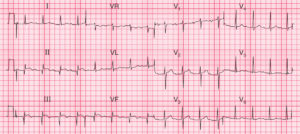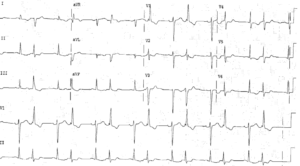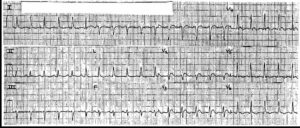ECG Interpretation
- Sinus rhythm, rate 91/min
- Normal PR interval
- Normal axis
- Normal QRS complexes
- Prolonged QT interval (QT = 492 ms; QTc = 598 ms)
- Inverted T waves in leads V2–V5
Clinical Interpretation
This is clearly a very abnormal ECG, with a markedly prolonged QT interval and abnormal T waves.
What to do ?
The family history suggests that this may well be an example of one of the congenital forms of prolonged QT interval: the Jervell–Lange–Nielson syndrome or the Romano–Ward syndrome.
These are characterized by episodes of loss of consciousness in children, often at times of increased sympathetic nervous system activity, and beta-blockers are the immediate form of treatment. The insertion of a permanent defibrillator may be necessary.
Prolonged QT interval syndrome is also associated with antiarrhythmic drugs (quinidine, procainamide, disopyramide, amiodarone and sotalol) and with other drugs such as the tricyclic antidepressants and erythromycin. Electrolyte abnormalities (low potassium, magnesium or calcium levels) also prolong the QT interval.




